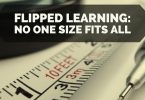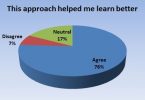--Originally published at Flipped Learning
As schools at all levels look for ways to empower students in learning, I have witnessed a great transform take place in how students approach Flipped Learning. In trying to create that 'perfect' classroom environment, I have recognized my truth and honesty with students from day one goes a long way in building trust with them. What I have found to be extremely successful is to share with them what Flipped Learning is and how each student will benefit from this approach in math class. And that starts by making them aware of my 4-C's to Flipped Learning.
Character: One of the greatest lessons students learn on day 1 is that Flipped Learning helps to build their character. I share with students that they are building character through responsibility, accountability, honesty, perseverance, valuing others, and critical thinking. I share with students right away that some of the math they learn may not be used again or in life, and some of the math might be used quite a bit. The key is to understand that they develop critical thinking skills and problem solving skills that they can take with them into any field they are interested in. This admission to students allows them to see that your honesty is of high value.
This allows me to show them how important their character becomes, not just in math class but in life. They learn that it is their responsibility to watch the video lessons and take accurate notes. They learn through group discussions that they are accountable for what they did and did not learn, and to ask questions when they are confused. They see that by being honest about not watching videos, others might be more willing to help them. We talk about persevering through difficult problems by using strategies learned in class to help them develop grit. And we demonstrate how valuing everyone in the class as an individual will benefit their learning in the long run. I spend a lot of time the first week building character in students so that I can set the bar high and empower them to be learners.
Collaboration: Perhaps the single most important element of my Flipped Learning environment, collaboration takes time to get right. Teaching students to fight the urge of 'copying' from one another takes patience and guidance. Teachers must be willing to demonstrate to students how collaboration works in a Flipped Learning classroom by modeling effective questioning techniques and dialogue. We spend time in the first few weeks to walk through and model group discussions and how to ask questions of each other without being critical. We demonstrate how to not directly answer questions, yet seek out more details about thought process. We talk about the non-visual language and the perceptions we give others when we don't speak or roll our eyes. Students really begin to understand that learning in my class is a community.
Choice: Students learn and see they have a lot of flexibility in my classes when it comes to choice. I don't believe in assigned seats (which subs don't like very much). I inform students that they develop character by making wise choices about whom to sit by, whom to group up with, and whom they seek out assistance from. I encourage them to change up their groups often so that they can learn different thinking skills and problem solving skills from classmates they may not always work with. I also give students a list of assignment options to choose from to demonstrate and reflect what they've learned each unit. In a sense, I create the sandbox for students to 'play' in, but I don't define the tools they can play with in that box. If they want to create a song - go for it. Develop an online blog - awesome! Or even design and edit a short film! The more choice I give students, the more ownership they take in their learning. And the more ownership they take, the more authentic the learning.
Creativity: What I started to witness over the years was that in providing students a safe, welcoming learning environment I actually designed a framework in which they become creative learners. Because each student knows they are building character through collaboration and choice, they begin to take risks to demonstrate their learning. Some draw on desks, others using chalk, and some technology. Students begin to work with students for different reasons and draw upon the creative individualism of each other. The talents and passions start to show and students share in awe and congratulations as projects and activities are completed. Students never cease to amaze me with their 'hidden' talents that come to life in math class. All because they know it's safe to fail, safe to learn, and encouraged to take risks!






Great article. Thanks.